
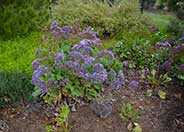
Common name:Sea Lavender, Statice
Botanical name:Limonium perezii
This mounding shrub will reach about 3' high and has large, dark green leaves with small blue and purple flowers that bloom in spring and summer.
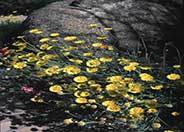
Common name:Desert Marigold
Botanical name:Baileya multiradiata
Fast growing annual or biennial forming soft clump of soft wooly gray leaves. Bright yellow daisy like flowers appear spring thru fall. At lower elevations, can bloom nearly year round. Full sun. Heat & drought tolerant. Needs good drainage. Will reseed some to establish. Flowers top at 12". Will rot with too much water. Little is needed even in the low desert. Native to mesas, plains in west, along roads to 5000'. Deadheading will prolong bloom. Great cut flower. Very cold hardy.
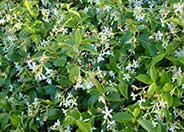
Common name:Star Jasmine, Confederate Jasmine
Botanical name:Trachelospermum jasminoides
The star jasmine is an evergreen vine that grows 20 ft. tall or a ground cover that reaches 1-2 ft. tall and 4-5 ft. wide. It has white fragrant flowers in the summer and can tolerate sun or partial shade. The star jasmine is also drought tolerant. -Cornflower Farms
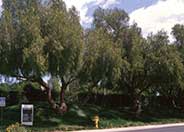
Common name:California Pepper, Mission Pepper
Botanical name:Schinus molle
The California Pepper is a fast-growing evegreen tree that will mature to a height of 25-40' and as wide. Its bright green leaves are divided into many narrow, 1 1/2-2" long leaflets.
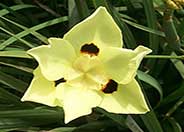
Common name:Yellow Moraea, Fortnight Lily
Botanical name:Dietes bicolor
This clumping perennial iris relative stands 3-4' high. It has light yellow iris-like flowers with maroon blotches that are about 2" wide. It performs best in full sun and in soil with good drainage.
More than half of the water used at your home is for outside purposes. Studies show that on average, half of the water used outdoors is wasted. The leading cause of waste is incorrectly set and poorly managed irrigation controllers. The second biggest cause of wastage is broken irrigation equipment that goes undetected. There are a few basic things you can do to make a big difference in your water use.
Click in the green box for more information
| Designer: Turner Fine Gardens | Pastels in the Garden |
Photographer: GardenSoft |
Practice grass-cycling by leaving short grass clippings on lawns after mowing, so that nutrients and organic matter are returned to the soil.
Mulching and adding compost to soil can minimize evaporation and help soil absorb and store water.
Remove irrigation water and fertilizer from areas where you don't want weeds to grow.